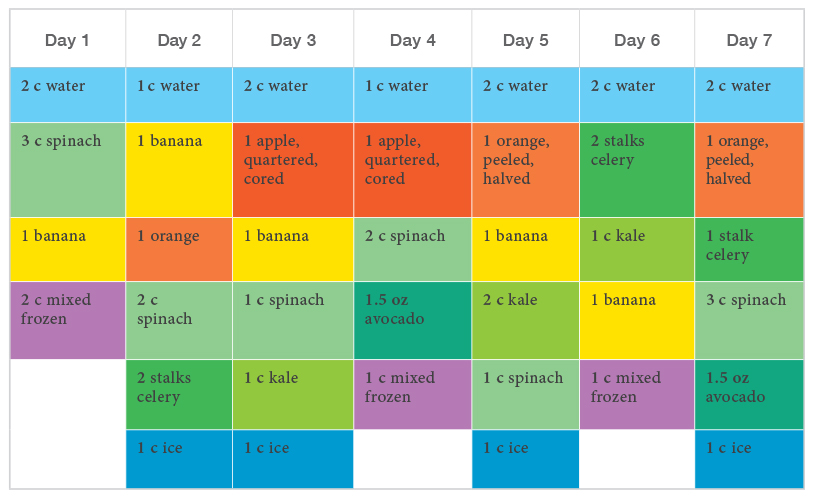A Week of Green Kale Smoothie Recipes

Eating leafy green vegetables provides many health benefits without adding loads of calories. Approximately 2 cups of leafy greens is only about 20 calories. Kale is jam-packed with vitamin C, which research shows is associated with reduced wrinkles and skin dryness.1 Consuming the vitamin C found naturally in leafy green vegetables and many fruits can also boost your immune system.2 Calcium is needed for increasing and maintaining bone strength. The calcium in many leafy greens is more bioavailable than the calcium in milk, making these vegetables a great choice. Additionally, leafy greens contain vitamin K, which also helps keep your bones strong. Gram for gram, leafy greens such as spinach, kale and chard contain more potassium than bananas, the potassium "poster child." Increased dietary potassium can help protect your heart and reduce your blood pressure.3 Leafy green vegetables are also an abundant source of folate. This essential vitamin is crucial in neural functions. Folate may also reduce the risk of depression and dementia and improve cognitive functioning.4 In addition to the many vitamins and minerals in leafy greens, these dark vegetables also contain fiber. Fiber helps keep your blood sugar level in the desired range and also keeps you feeling full longer, which will help you avoid unnecessary snacking.5  Blendtec's Garden Green Giant Juice Now that you know many of the health benefits to leafy greens, you may be wondering how to increase these nutritious vegetables in your diet. A great way to start is with kale green smoothies, especially if you're not yet a fan of eating leafy greens in savory dishes or salads. We've prepared a whole week of green smoothies so you can dive right into a healthier diet. Following the menu below will guide you through the different types of greens and flavor combinations. And while the menu keeps your shopping list to a minimum, it maximizes flavor. Here is what you'll need for a full week of green smoothies:
Blendtec's Garden Green Giant Juice Now that you know many of the health benefits to leafy greens, you may be wondering how to increase these nutritious vegetables in your diet. A great way to start is with kale green smoothies, especially if you're not yet a fan of eating leafy greens in savory dishes or salads. We've prepared a whole week of green smoothies so you can dive right into a healthier diet. Following the menu below will guide you through the different types of greens and flavor combinations. And while the menu keeps your shopping list to a minimum, it maximizes flavor. Here is what you'll need for a full week of green smoothies:
 Blendtec's Garden Green Giant Juice Now that you know many of the health benefits to leafy greens, you may be wondering how to increase these nutritious vegetables in your diet. A great way to start is with kale green smoothies, especially if you're not yet a fan of eating leafy greens in savory dishes or salads. We've prepared a whole week of green smoothies so you can dive right into a healthier diet. Following the menu below will guide you through the different types of greens and flavor combinations. And while the menu keeps your shopping list to a minimum, it maximizes flavor. Here is what you'll need for a full week of green smoothies:
Blendtec's Garden Green Giant Juice Now that you know many of the health benefits to leafy greens, you may be wondering how to increase these nutritious vegetables in your diet. A great way to start is with kale green smoothies, especially if you're not yet a fan of eating leafy greens in savory dishes or salads. We've prepared a whole week of green smoothies so you can dive right into a healthier diet. Following the menu below will guide you through the different types of greens and flavor combinations. And while the menu keeps your shopping list to a minimum, it maximizes flavor. Here is what you'll need for a full week of green smoothies:
- 12 c spinach
- 4 c kale
- 5 stalks celery
- 3 oz avocado
- 5 bananas
- 3 oranges
- 2 apples
- 4 c frozen fruit
- Water and ice

- Cosgrove MC, Franco OH, Granger SP, Murray PG, Mayes AE. Dietary nutrient intakes and skin-aging appearance among middle-aged American women. Am J Clin Nutr. 2007; 86:1225–1231.
- Fashner J, Ericson K, Werner S. Treatment of the common cold in children and adults. Am Fam Physician. 2012; 15; 86(2):153–9.
- Kohlenberg-Mueller K, Raschka L. Calcium balance in young adults on a vegan and lactovegetarian diet. J Bone Miner Metab. 2003; 21:28–33.
- Haddy FJ, Vanhoutte PM, Feletou M. Role of potassium in regulating blood flow and blood pressure. Am J Physiol Regul Integr Comp Physiol. 2006; 290:R546-R552.
- Mischoulon D, Raab MF. The role of folate in depression and dementia. J Clin Psychiatry. 2007; 68[suppl 10]:28–33.
- Slavin JL. Position of the American Dietetic Association: Health implications of dietary fiber. J Am Diet Assoc. 2008; 108:1716–1731.


I am a Type 1 diabetic. I do not need to lose weight as I am 6’4 220. Can I drink these smoothies inbetween meals to help maintain a healthy Blood Glucose? I am ordering my Blendtec today. Will the recipe book offer other receipes for a Type 1 diabetic?
Since the smoothies are two servings, if I wanted to have one for breakfast and one for lunch or dinner, would it be best to refrigerate or freeze the other portion?
You can just remove the banana altogether. It just gives it a little extra creaminess. You could try using yogurt.
Nice recipe, but I don’t like banana can you suggest me other alternative instead of banana.
I don’t like bananas and was wondering if I could substitute an orange or apple instead?
Leave a comment